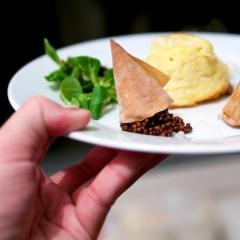-
Posts
346 -
Joined
-
Last visited
Contact Methods
-
Website URL
https://mundschenk.at
Profile Information
-
Location
Austria
Recent Profile Visitors
25,322 profile views
-
Texture or no texture should not matter in a chamber vacuum machine. What problems do you experience with the textured bags, @Shelby?
-
I don't know this specific model, but gaskets are basically long silicon strips that are pushed into a seam. At one point, the two ends do have to come together.
-
I would suggest clarified butter to prevent the solids from burning.
-
I haven't been there myself, so I can't anything about the quality of the Schnitzel, but they use all the proper ingredients. (It's a bit too tourist-y for my tastes. The original restaurant of the same name was destroyed in 1945 and the new Meissl & Schadn opened six months ago.)
-
Traditional recipes here include both steps, butterflying and pounding. However, nowadays there is (mostly) a consensus that anything but a relatively light pounding is detrimental to meat texture and juiciness.
-
You could try butterflying the chops instead of pounding them.
-
Sure. Schnitzel is just the particular cut of meat (lean meat, thinly cut, possibly butterflied).
-
While it may very well be the case for your menu, it's certainly not true for all of Germany. There is a lot of regional variation (much more than Austrians talking about German cuisine usually credit). Just look at the recipes/pictures on Chefkoch.de or at the East German Jägerschnitzel made of breaded sliced sausage.
-
"k.u.k." means "kaiserlich und königlich" (imperial and royal), refering to the institutions of Austria-Hungary as a whole instead of either of the two parts (the Austrian lands being the Kaisertum Österreich (the Austrian Empire), whereas Hungarian parts where known as the Länder der Heiligen Ungarischen Stephanskrone (the Lands of the Sacred Hungarian Crown of St. Stephen). To confuse things "k.k.", i.e. "kaiserlich-königlich", was used as well, for institutions in the Austrian half (because the emperor was also King of Bohemia and a few lesser kingdoms). This is all post-1867, BTW. Before that, the empire was a unitary state. As for the recipe itself, I'd assume the name is something invented by Gerlach, as I've never heard of that term before.
-
There is a classical preparation that's fairly well documented in the literature (e.g. Franz Maier-Bruck's Die österreichische Küche). Regarding the theory that field marshall Radetzky brought back the Wiener Schnitzel from one of his campaigns in Italy, that has been pretty thoroughly debunked by Heinz Pohl (German only, sorry). It's a fairly newish invention, arising only in the late 19th century. The name Wiener Schnitzel is probably after the older Wiener Backhendl (Viennese fried chicken) with which it shares the breading technique. Traditional side dishes for the Wiener Schnitzel are either cucumber or potato salad, although buttered potatoes with parsley are also sort-of OK. A lemon wedge is mandatory, fried parsley an optional garnish. Outside of Vienna, especially the farther west you go, you will be served Preiselbeermarmelade (a fruit akin to cranberries) and maybe even rice. While these may be minor heresies, you will never, ever be served any kind of sauce with your Wiener Schnitzel in Austria.
-
As a native Austrian, I've got some comments here. These three are normally not breaded. These three (with the partial exception of Holsteiner Schnitzel, which historically was breaded and is not nowadays) are indeed breaded and sauced. (As an Austrian, I've very strong feelings about the kind of people who would do such a thing ... let's just say there's a reason we don't think much of German cuisine ;-) ) Not breaded as far as I've seen on the internet. A recipe based on the 50s invention of Toast Hawaii, not breaded in my cook books from the era. Yes and no. First of all, not everything called "Schnitzel" is breaded and fried. Secondly, culinary speaking, Germany is not a unified country at all. Thirdly, while you will certainly find people (and maybe even restaurants) that make a Jägerschnitzel by making a Wiener Schnitzel and slopping a can of mushrooms over it, that's not the classical recipe at all.
-
Not sure how filtration with agar in conjunction with gelatin would work. As far as I understand agar filtration, it works by exploiting syneresis, i.e. the "sweating" of the liquid phase from the agar gel. Gelatin, especially at temperatures below 37 °C, would mostly prevent that effect (by binding more water). Also, even if syneresis occurs in these conditions, the yield would probably be low and the body (gelatin) be lost from the stock. I'm not sure if the technique is useful at all for clarifying gelatinous stocks, but if so, you'd probably have to keep the liquid between the melting points of gelatin and agar.
-
Unless that unit has really crappy seal bars, I doubt that. The "waffled" bags probably don't get mentioned because they are more expensive and being able to use chamber vacuum bags is a "feature" that can be promoted.
-

[Modernist Cuisine] How does one use the kitchen guide
pep. replied to a topic in Cookbooks & References
Unfortunately, all the PDFs are gone as of a few days ago -
TG is transglutaminase AKA "meat glue". Activa GS is a mixture of TG with gelatin, used for slurry applications.










